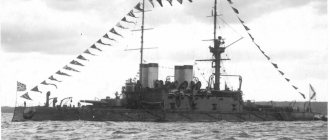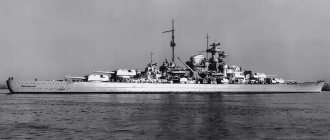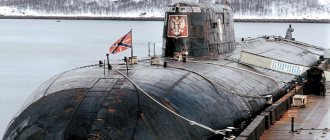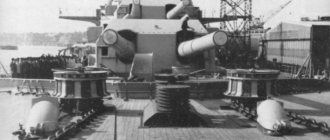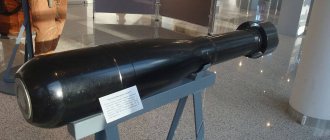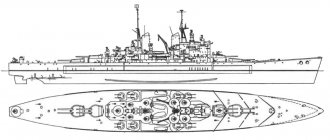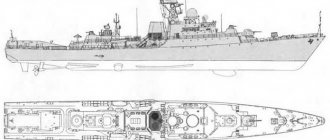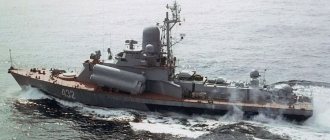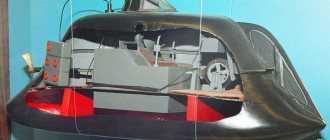As you know, the squadron battleship Oslyabya was destined to head the mournful list of Russian ships lost in the Battle of Tsushima. At 13.49, “Prince Suvorov” opened fire, and at 14.40, that is, only 51 minutes after the start of the battle of the main forces, “Oslyabya” capsized. And we can safely say that its death was predetermined even earlier, since at 14.20, when the battleship left the formation, it was already doomed: by that time the Oslyabya had a list of 12 degrees. on the left side and sat in the water with his nose up to the hawse.
At the same time, the same type of "Oslyab" "Peresvet" with honor endured all the hardships of the battle of Shantung, which took place on July 28, 1904, despite the fact that it was hit by at least 37 shells, including 13 305 mm caliber. In fact, Peresvet turned out to be the most damaged Russian ship in that battle, but it managed not only to survive the battle, but also to return to Port Arthur on its own.
Why did one battleship die and the second survive? The question is all the more interesting because, according to the data available today, the ships received largely comparable, similar damage. In the proposed series of articles I will try to find the answer to this question.
A short preface
Since “Oslyabya” was killed in battle, no one, of course, could at least comprehensively study and systematize the calibers of the shells that hit it, the number and time of hits. If the damage to the squadron battleship "Peresvet" received in the battle on July 28, 1904 in the Yellow Sea was scrupulously recorded and described, then for the "Oslyaba" researchers of the future received only very fragmentary information from the reports of Russian and Japanese sailors. The available evidence can be divided into 3 main categories.
Category 1 is, of course, the evidence of the Oslyabi crew members. They are the most valuable and reliable, since these people were on the battleship and saw what was happening to it with their own eyes. However, this does not make such evidence the ultimate truth - given the turmoil of the battle and the strong psychological trauma caused by the death of the battleship, their evidence may be somewhat confusing or contain an approximate assessment of a particular event (for example, the caliber of the hit projectile).
Category 2 - evidence of Russian sailors from “neighboring” warships who had the opportunity to observe the execution of the “Oslyabi” from a relatively short distance. Taking into account the fact that Z.P. Rozhdestvensky established the intervals between armored ships at 2 cable lengths, from the Sisoy the Great and Orel they could see the Oslyabya from a distance of no more than 350 meters, and taking into account the crowding of Russian ships at the beginning of the battle – and less than the specified value. But still, there may be noticeably more confusion and observation errors. There were no idle sailors among our sailors, everyone was busy with their own business, and, obviously, the sailors and officers of other ships could not, and did not have such a duty, to constantly monitor the Oslyabya. Accordingly, their evidence could be significantly distorted and largely erroneous.
Finally, certificates of Japanese sailors should be included in category 3. They, of course, knew well what they were doing themselves, but they only had an approximate idea of what was happening with Oslyabya, simply because Oslyabya was located at a considerable distance from them.
Links[edit]
- Campbell, N. J. (1978). Preston, Anthony (ed.). Battle of Tsu-Shima, parts 1, 2, 3 and 4
.
II
. London: Conway Maritime Press. pp. 46–49, 127–35, 186–92, 258–65. ISBN 0-87021-976-6. - Forczyk, Robert (2009). Russian battleship versus Japanese battleship, Yellow Sea 1904–05
. Oxford, UK: Osprey. ISBN 978-1-84603-330-8. - Krestyaninov, Vasily (1998). "Peresvet-class battleships (Peresvet-class battleships)". Marine collection
. Khimki, Russia: Collection (1). OCLC 436873057. - McLaughlin, Stephen (2003). Russian and Soviet battleships
. Annapolis, MD: Naval Institute Press. ISBN 1-55750-481-4. - Pleshakov, Konstantin (2002). The Tsar's Last Armada: An Epic Journey to the Battle of Tsushima. New York: Basic Books. ISBN 0-465-05791-8.
- Schrad, Mark Lawrence (2014). Vodka Politics: Alcohol, Autocracy and the Secret History of the Russian State. Oxford, UK: Oxford University Press. ISBN 978-0-19-975559-2.
- Silverstone, Paul H. (1984). Directory of the World's Capital Ships
. New York: Hippocrene Books. ISBN 0-88254-979-0. - Taras, Alexander (2000). Ships of the Russian Imperial Navy 1892-1917
[
Ships of the Imperial Russian Navy 1892-1917
]. Library of Military History (in Russian). Minsk, Russia: Harvest. ISBN 978-985-433-888-0.
Word to Captain Obvious
Let's start with the simplest one. The squadron battleship Oslyabya died as a result of loss of stability: it had a strong trim on the bow and heeled to the left side until it lay on it, and then turned over and sank. It is quite obvious that the ship suffered extensive flooding of the bow compartments and rooms on the port side, which was the cause of its death. It is no less obvious that such flooding occurred as a result of damage to the hull caused by enemy shells that hit the Oslyabi waterline area.
Thanks, Cap!
Due to the above, the author of this article does not set himself the task of identifying, counting and studying all the hits in Oslyabya. This is, frankly, a thankless task, and not necessary for our purposes. Let's focus better on studying the hits that caused the flooding mentioned above.
Japanese data
Judging by the information available to the author, the decisive damage to the Oslyaba was inflicted by the Japanese battleship Fuji. His gunners believed that they had scored three hits with 305-mm shells on the left side of the Russian ship - and all of them hit the waterline. The first twelve-inch shell hit the Russian ship in the bow, unarmored part of the hull at approximately 13.56 (hereinafter - Russian time). Then, at 14.12, almost simultaneously, two more 305-mm “suitcases” hit Oslyabya. One of them, we will consider it the second in a row, hit the area of coal pit No. 10. And one more, the third, hit a Russian battleship in the immediate vicinity of the site of the first hit.
Approximate locations where 305-mm Fuji shells hit Oslyabya
Of course, in addition to the Fuji, other Japanese ships also fired at the Oslyabya. It cannot be ruled out that the Russian ship received some more heavy 254-305 mm “suitcases” from the Kasuga and Shikishima. Without a doubt, the Japanese achieved numerous hits on the Oslyabya with 152-203 mm caliber shells. But, as far as the author knows, no other shell hits in the Oslyabi waterline area, besides those listed above, were observed from the ships of the United Fleet.
Footnotes [edit]
- ^ab Forcsik, page 62
- McLaughlin, page 108
- McLaughlin, pp. 107-08, 114
- McLaughlin, pp. 107-08, 112-13
- McLaughlin, pp. 107-08, 113-14
- Silverstone, page 380
- McLaughlin, pp. 107, 110, 112, 114-15
- ^ abc Krestyaninov, Films and death “Weakening”
- McLaughlin, page 166
- Forcik, page 9
- Shrad, page 163
- Pleshakov, s. 92
- McLaughlin, page 167
- Forczyk, pp. 25, 56
- Jump up
↑ McLaughlin, pp. 114, 167 - Forczyk, pp. 56, 61
- Forczyk, pp. 61-62
- ^ ab Campbell, pp. 128–31
- McLaughlin, page 168
- Taras, s. 28
Reports and reports from Oslyabi crew members
Of the three hits of 305-mm shells in the area of the waterline on the port side, Russian sailors from the Oslyabi absolutely confirm two - into the unarmored side in the bow, and into coal pit No. 10. This, of course, does not mean that the third 305-mm Fuji projectile missed the target. But the fact is that both of the above hits produced a very noticeable effect and required significant efforts from the crew to correct the damage received. At the same time, our sailors did not seem to notice the third hit of a 305-mm shell from the Fuji: it can be assumed that even if it was, it did not cause noticeable harm to the battleship, or there was no one left alive who could describe the harm, why it was not recorded.
Design and description[edit]
Peresvet class design
" was inspired by the British Centurion - class second - class battleships .
The British ships were intended to engage merchant raiders such as the Russian armored cruisers Rossiya and Rurik; The Peresvet
-class ships were intended to support Russian cruisers. This role emphasized high speed and long range through heavy weaponry and armor. [2]
Oslyabya
had an overall length of 434 ft 5 in (132.4 m), a beam of 71 ft 6 in (21.79 m) and a draft of 26 ft 3 in (8.0 m).
Designed to displace 12,674 long tons (12,877 t), she was nearly 2,000 long tons (2,000 t) overweight and displaced 14,408 long tons (14,639 t) when built. Her crew consisted of 27 officers and 744 enlisted men. The ship was powered by three vertical triple expansion steam engines using steam generated by 30 Belleville boilers. The engines were rated at 14,500 horsepower (10,800 kW) using forced draft, and designed to achieve a top speed of 18 knots (33 km/h; 21 mph). Oslyabya
, however, achieved a top speed of 18.33 knots (33.95 km/h; 21.09 mph) with 15,051 horsepower (11,224 kW) during sea trials in September 1902. She carried a maximum of 2,060 long tons (2,090 t) of coal. allowing her to sail 6,200 nautical miles (11,500 km; 7,100 mi) at 10 knots (19 km/h; 12 mph). [3]
The ship's main battery consisted of four 10-inch (254 mm) guns mounted in two twin-gun turrets, one forward and one aft of the superstructure. Secondary armament consisted of eleven Canet 6 in (152 mm) rapid fire (QF) guns mounted in casemates on the sides of the hulls and in the bow, under the forecastle. Smaller guns were used to defend against torpedo boats. These included twenty 75 mm (3.0 in) QF guns, twenty 47 mm (1.9 in) Hotchkiss guns, and eight 37 mm (1.5 in) guns. It was also armed with five 15-inch (381 mm) torpedo tubes, three surface-mounted and two submerged. The ship was carrying 45 mines, which were to be used to protect the anchorage. [4]
Oslyabya
's waterline armor belt consisted of Harvey armor and was four to nine inches (102 to 229 mm) thick. The strap was 7 feet 9 inches (2.4 m) high, of which the top 36 inches (910 mm) would have been above the waterline, but the ship was significantly heavier and had only three inches (76 mm) under normal load. . At full load the strap was completely submerged and her only protection was the four-inch top strap. The cemented armor platter of her gun turrets had a maximum thickness of nine inches and her deck ranged from two to three inches (51 to 76 mm) in thickness. [5]
First hit
It was best described by the Oslyabi mine officer, Lieutenant Mikhail Petrovich Sablin 1st:
“One of the first shots hit the living deck near the first bow bulkhead from the left side. Through the hole caused by this shell, water entered the first and second compartments of the living deck, and through the cracks formed in the deck, through the hatch and into the broken fan pipes, it went into the left bow 6-inch magazine and into the turret compartment. The hole was underwater, but due to the movement and strong swell, it could not be repaired. The spread of water along the living deck was stopped by the second bulkhead, ahead of the bow beam, and in the holds the water reached the compartment of the bow dynamos and underwater vehicles.”
How did the lieutenant know so well the damage caused by this Japanese heavy shell? As follows from his report, the commander of the Oslyabi, captain 1st rank V.I. Behr, ordered Lieutenant Sablin to be at the “electrical installations”, which were located in close proximity to the underwater mine compartment. Although this is not said directly, it is quite obvious from the context that we are talking about the premises of dynamos. Immediately after the hit, Sablin went to the living deck: “When we received a hole in the bow compartment, the smoke in the 1st and 2nd bow compartments was so thick that the incandescent light bulbs were completely invisible and there was complete darkness. Assuming that the wires were broken there, I went there with a repair party.”
Arriving on the living deck, Sablin found senior officer Pokhvistnev and a bilge mechanic there. Sablin ventilated the premises by opening the porthole on the starboard side, and, apparently, checked the electrics for some time (he does not write about this directly), but did not participate in sealing the resulting hole. This follows from his own report: “After a while I asked the senior officer how they dealt with the hole. He replied that it was impossible to repair the hole, but the water had been dealt with and the hole now poses no danger.”
Apparently, by this time the Oslyaby did not yet have a strong trim on the bow, and the ship had only a slight roll, otherwise D. B. Pokhvistnev, obviously, would not have been so optimistic about the possible threat. Lieutenant M.P. Sablin tried to return to his department, but he failed: “I wanted to go to the underwater vehicles department, but the hatch there was battened down and there was 2 feet of water above it. I inquired by phone - how was it with them, they answered that everything was fine. The bow dynamos located under the underwater vehicle compartment worked properly.”
Why did this happen? The fact is that this hatch was battened down from below by mine-vehicle conductor V. Zavarin, who indicated in his report:
“I went down to my mine apparatus and dynamo machine, but not even 10 minutes had passed (this happened immediately after the start of the battle - author’s note), when our battleship was hit in the bow by an enemy 12-inch shell, which made a hole on the surface, interrupted ventilation pipes; although the hole was repaired, before repair, water entered the underwater mine vehicles. I temporarily left the mine apparatus compartment to batten down the neck of the armored cover, which I succeeded in doing.” Having closed the lid, the conductor returned, saw that water continued to flow through the ventilation pipes and ordered them to be sealed. At that moment, Sablin managed to contact him: “How is it, Zavarin, how are you, can you manage?” I replied that there is not much water, I can manage it.”
Subsequently, Lieutenant M.P. Sablin, apparently, no longer descended below the level of the living deck, since he does not mention anything about this. It should be noted that his report is extremely detailed, but, of course, it does not contain minute-by-minute timekeeping, but only outlines the sequence of actions performed by this officer. As mentioned earlier, at the beginning of the battle he was somewhere near the dynamos, then, after 13.56, when a 305-mm shell hit the bow of the Oslyabi, he went to the living deck, repaired or checked something there, and had a conversation with a senior officer, was unable to return, but managed to contact the submersible department. All this took him 16 minutes, and then the Oslyabya was hit by the second, and perhaps the second and third, 305-mm shells from the Fuji.
About the reasons for the death of the squadron battleship "Oslyabya"
As you know, the squadron battleship Oslyabya was destined to head the mournful list of Russian ships lost in the Battle of Tsushima.
At 13.49, “Prince Suvorov” opened fire, and at 14.40, that is, only 51 minutes after the start of the battle of the main forces, “Oslyabya” capsized. And we can safely say that its death was predetermined even earlier, since at 14.20, when the battleship left the formation, it was already doomed: by that time the Oslyabya had a list of 12 degrees. on the left side and sat in the water with his nose up to the hawse. At the same time, the same type of "Oslyab" "Peresvet" with honor endured all the hardships of the battle of Shantung, which took place on July 28, 1904, despite the fact that it was hit by at least 37 shells, including 13 305 mm caliber. In fact, Peresvet turned out to be the most damaged Russian ship in that battle, but it managed not only to survive the battle, but also to return to Port Arthur on its own.
Why did one battleship die and the second survive? The question is all the more interesting because, according to the data available today, the ships received largely comparable, similar damage. In the proposed series of articles I will try to find the answer to this question.
A short preface
Since “Oslyabya” was killed in battle, no one, of course, could at least comprehensively study and systematize the calibers of the shells that hit it, the number and time of hits.
If the damage to the squadron battleship "Peresvet" received in the battle on July 28, 1904 in the Yellow Sea was scrupulously recorded and described, then for the "Oslyaba" researchers of the future received only very fragmentary information from the reports of Russian and Japanese sailors. The available evidence can be divided into 3 main categories. Category 1 is, of course, the evidence of the Oslyabi crew members. They are the most valuable and reliable, since these people were on the battleship and saw what was happening to it with their own eyes. However, this does not make such evidence the ultimate truth - given the turmoil of the battle and the strong psychological trauma caused by the death of the battleship, their evidence may be somewhat confusing or contain an approximate assessment of a particular event (for example, the caliber of the hit projectile).
Category 2 - evidence of Russian sailors from “neighboring” warships who had the opportunity to observe the execution of the “Oslyabi” from a relatively short distance. Taking into account the fact that Z.P. Rozhdestvensky established the intervals between armored ships at 2 cable lengths, from the Sisoy the Great and Orel they could see the Oslyabya from a distance of no more than 350 meters, and taking into account the crowding of Russian ships at the beginning of the battle – and less than the specified value. But still, there may be noticeably more confusion and observation errors. There were no idle sailors among our sailors, everyone was busy with their own business, and, obviously, the sailors and officers of other ships could not, and did not have such a duty, to constantly monitor the Oslyabya. Accordingly, their evidence could be significantly distorted and largely erroneous.
Finally, certificates of Japanese sailors should be included in category 3. They, of course, knew well what they were doing themselves, but they only had an approximate idea of what was happening with Oslyabya, simply because Oslyabya was located at a considerable distance from them.
Word to Captain Obvious
Let's start with the simplest one.
The squadron battleship Oslyabya died as a result of loss of stability: it had a strong trim on the bow and heeled to the left side until it lay on it, and then turned over and sank. It is quite obvious that the ship suffered extensive flooding of the bow compartments and rooms on the port side, which was the cause of its death. It is no less obvious that such flooding occurred as a result of damage to the hull caused by enemy shells that hit the Oslyabi waterline area. Thanks, Cap!
Due to the above, the author of this article does not set himself the task of identifying, counting and studying all the hits in Oslyabya. This is, frankly, a thankless task, and not necessary for our purposes. Let's focus better on studying the hits that caused the flooding mentioned above.
Japanese data
Judging by the information available to the author, the decisive damage to the Oslyaba was inflicted by the Japanese battleship Fuji. His gunners believed that they had scored three hits with 305-mm shells on the left side of the Russian ship - and all of them hit the waterline. The first twelve-inch shell hit the Russian ship in the bow, unarmored part of the hull at approximately 13.56 (hereinafter - Russian time). Then, at 14.12, almost simultaneously, two more 305-mm “suitcases” hit Oslyabya. One of them, we will consider it the second in a row, hit the area of coal pit No. 10. And one more, the third, hit a Russian battleship in the immediate vicinity of the site of the first hit.
Approximate locations where 305-mm Fuji shells hit Oslyabya
Of course, in addition to the Fuji, other Japanese ships also fired at the Oslyabya. It cannot be ruled out that the Russian ship received some more heavy 254-305 mm “suitcases” from the Kasuga and Shikishima. Without a doubt, the Japanese achieved numerous hits on the Oslyabya with 152-203 mm caliber shells. But, as far as the author knows, no other shell hits in the Oslyabi waterline area, besides those listed above, were observed from the ships of the United Fleet.
Reports and reports from Oslyabi crew members
Of the three hits of 305-mm shells in the area of the waterline on the port side, Russian sailors from the Oslyabi absolutely confirm two - into the unarmored side in the bow, and into coal pit No. 10. This, of course, does not mean that the third 305-mm Fuji projectile missed the target. But the fact is that both of the above hits produced a very noticeable effect and required significant efforts from the crew to correct the damage received. At the same time, our sailors did not seem to notice the third hit of a 305-mm shell from the Fuji: it can be assumed that even if it was, it did not cause noticeable harm to the battleship, or there was no one left alive who could describe the harm, why it was not recorded.
First hit
It was best described by the Oslyabi mine officer, Lieutenant Mikhail Petrovich Sablin 1st:
“One of the first shots hit the living deck from the left side near the first bow bulkhead. Through the hole caused by this shell, water entered the first and second compartments of the living deck, and through the cracks formed in the deck, through the hatch and into the broken fan pipes, it went into the left bow 6-inch magazine and into the turret compartment. The hole was underwater, but due to the movement and strong swell, it could not be repaired. The spread of water along the living deck was stopped by the second bulkhead, ahead of the bow beam, and in the holds the water reached the compartment of the bow dynamos and underwater vehicles.”
How did the lieutenant know so well the damage caused by this Japanese heavy shell? As follows from his report, the commander of the Oslyabi, captain 1st rank V.I. Behr, ordered Lieutenant Sablin to be at the “electrical installations”, which were located in close proximity to the underwater mine compartment. Although this is not said directly, it is quite obvious from the context that we are talking about the premises of dynamos. Immediately after the hit, Sablin went to the living deck: “When we received a hole in the bow compartment, the smoke in the 1st and 2nd bow compartments was so thick that the incandescent light bulbs were completely invisible and there was complete darkness. Assuming that the wires were broken there, I went there with a repair party.”
Arriving on the living deck, Sablin found senior officer Pokhvistnev and a bilge mechanic there. Sablin ventilated the premises by opening the porthole on the starboard side, and, apparently, checked the electrics for some time (he does not write about this directly), but did not participate in sealing the resulting hole. This follows from his own report: “After a while I asked the senior officer how they dealt with the hole. He replied that it was impossible to repair the hole, but the water had been dealt with and the hole now poses no danger.”
Apparently, by this time the Oslyaby did not yet have a strong trim on the bow, and the ship had only a slight roll, otherwise D. B. Pokhvistnev, obviously, would not have been so optimistic about the possible threat. Lieutenant M.P. Sablin tried to return to his department, but he failed: “I wanted to go to the underwater vehicles department, but the hatch there was battened down and there was 2 feet of water above it. I inquired by phone - how was it with them, they answered that everything was fine. The bow dynamos located under the underwater vehicle compartment worked properly.”
Why did this happen? The fact is that this hatch was battened down from below by mine-vehicle conductor V. Zavarin, who indicated in his report:
“I went down to my mine apparatus and dynamo machine, but not even 10 minutes had passed (this happened immediately after the start of the battle - author’s note), when our battleship was hit in the bow by an enemy 12-inch shell, which made a hole on the surface, interrupted ventilation pipes; although the hole was repaired, before repair, water entered the underwater mine vehicles. I temporarily left the mine apparatus compartment to batten down the neck of the armored cover, which I succeeded in doing.” Having closed the lid, the conductor returned, saw that water continued to flow through the ventilation pipes and ordered them to be sealed. At that moment, Sablin managed to contact him: “How is it, Zavarin, how are you, can you manage?” I replied that there is not much water, I can manage it.”
Subsequently, Lieutenant M.P. Sablin, apparently, no longer descended below the level of the living deck, since he does not mention anything about this. It should be noted that his report is extremely detailed, but, of course, it does not contain minute-by-minute timekeeping, but only outlines the sequence of actions performed by this officer. As mentioned earlier, at the beginning of the battle he was somewhere near the dynamos, then, after 13.56, when a 305-mm shell hit the bow of the Oslyabi, he went to the living deck, repaired or checked something there, and had a conversation with a senior officer, was unable to return, but managed to contact the submersible department. All this took him 16 minutes, and then the Oslyabya was hit by the second, and perhaps the second and third, 305-mm shells from the Fuji.
Second hit
Sablin notes in the report:
“... the shell hit the 10th coal pit from the left side, piercing the armor. Then water appeared in the left emergency cruise chamber, and the list began to increase. When the list began, they began to fill the three side corridors on the right side with water, and then, as the list increased, the right cartridge magazines.”
How did he know all this? As follows from his own report, Sablin managed to talk with the bilge mechanic and the ship's engineer Zmachinsky, who insisted that it was necessary not to limit oneself to the onboard corridors alone, but to urgently “counter-flood” the cartridge magazines. Sablin himself received instructions to start turbines No. 4-6, and only here he mentions the trim that appeared on the bow: “The roll continued to increase, and we landed with our nose.”
Then Sablin tried to contact his mine team, located in the department of underwater mine vehicles and in the dynamo department, but it turned out that neither the telephone nor the voice communication were no longer working. Then he sent miner Chernov down, who was supposed to go down through the bow tower and order everyone to get out and batten down the hatches. Realizing that this would lead to the stopping of the dynamos, Sablin decided to start up the others that were in the batteries. But the lieutenant no longer tried to go down into the hold or establish contact with those who were in it.
What was happening to the mine team at this time? V. Zavarin points out:
“The ship began to list; I ordered to open the release valve, which drains water from the underwater mine apparatus room and in the hold of the dynamos, and start the turbines to pump out the water accumulated in the underwater mine apparatus room; then he ordered a look in the turret compartment to see if there was water; there, too, water came through the ventilation pipes, which flooded the premises; all this was fixed in a timely manner"
. This fragment of the report contains an implicit indication of the time of what is happening. A slight roll of the Oslyabi appeared after the first hit, as indicated by Lieutenant Sablin. And it would be strange for him not to appear: after all, the water spread across the living deck, flooding it (at least) 60 centimeters, which led to a significant overload and flowed into the hold. But this roll, apparently, did not increase, or at least did not increase noticeably, otherwise the senior officer of the battleship would have no reason to consider the hole safe. A sharp increase in roll occurred only after the second Japanese 305-mm shell hit coal pit No. 10, as a result of which both this pit and the left hook chamber were flooded. Thus, the above excerpt from V. Zavarin’s report refers to the moment when “Oslyabya” received the second (or second and third) hit.
We see from his report that the mine team fought against the flow of water, but this fight was unsuccessful: the measures taken did not help. In the testimony of the Investigative Commission, V. Zavarin indicated:
“I opened the release valve and the water went into the hold, then, to pump out the water, I turned on the turbines, but apparently this did not help, since water began to penetrate into the turret compartment, which was soon flooded, and I ordered the room to be sealed and everything was tightly sealed close."
Seeing that his actions were not successful, V. Zavarin tried to turn to the mine officer, that is, to Lieutenant Sablin:
“I went to the phone, I wanted to ask the mine officer what to do and how to do it, because the ship was tilting very much and water was adding to the premises, but it turned out that the phone was not working. I went to the communication pipes, which were also broken; at that time there was a command: “Escape through the tower as best you can,” because the battleship began to list very quickly.”
Apparently, Sablin and V. Zavarin tried to contact each other at about the same time, but both failed, since the telephone and voice communications no longer worked. And then, probably, the miner Chernov, sent by Sablin, “arrived” - although this is not stated directly anywhere, most likely it was he who gave the order to the mine team to leave through the tower. Which she did, having first stopped the dynamos and battened down the hatches.
The death of "Oslyabi"
According to the testimony of midshipman Shcherbachev of the 4th (squadron battleship "Eagle"), by the time the "Oslyabi" broke down at 14.20, the ship had a strong list to the left side and was sitting with its bow right up to the hawse. The author is inclined to trust this judgment, since the observation was carried out at an extremely short distance, from which it would be difficult to make a mistake, and it is fully confirmed by the testimony of other eyewitnesses. In this position, the port ship found its battery deck in close proximity to the water.
M.P. Sablin wrote:
“When the list was very great and water began to flow into the living deck through the hatches and the fan from the battery, I went up to the battery deck and saw that water was pouring into the gun ports of the battery... Then I called several crew members and wanted to batten down the neighboring port, but soon became convinced that this was impossible. The semi-porticos were broken, and when there was a wave, the water rushed into the entire port, knocked out the suitcases and covered us completely.”
Obviously, being in such a position, the squadron battleship Oslyabya could no longer count on salvation. He was doomed for the simple reason that the flow of water into his hull had become completely uncontrollable - the battery deck was heavily flooded, and the emergency parties could no longer do anything about it. But a very interesting nuance attracts attention - M.P. Sablin points to the flow of water precisely through the battery port, and not through the holes in the Oslyabi’s body. After another 20 minutes, at 14.40. "Oslyabya" turned over.
Results and conclusions
First, let's look at the diagram of the bow of the ship and determine where exactly mine officer M.P. was and where he was going. Sablin and conductor V. Zavarin. The yellow shading indicates the dynamo room, the green shading indicates the underwater mine compartment, and the red line is the living deck
The image shows a fragment of a longitudinal section of the battleship "Peresvet", but they and the "Oslyabya" were of the same type
As you can see, none of the Oslyabi crew who survived the Tsushima battle and wrote reports “to the authorities” had the opportunity to observe the compartments located forward of the turret compartment of the bow 10-inch tower and below the living deck (circled in the diagram blue). Thus, of course, we have no way of knowing for sure what happened there. However, from the testimony of V. Zavarin and M.P. Sablin we know that:
1. As a result of a 305-mm shell hitting the bow of the battleship at the level of the living deck, water not only spilled over this deck, but also began to penetrate through hatches, deck cracks and ventilation shafts into the rooms below it.
2. At the same time, water very actively flooded even rooms very remote from the site of the shell explosion, such as the 6-inch cartridge magazine, the rooms of underwater mine vehicles (it was located immediately behind the compartment of underwater mine vehicles
From this we can assume that the rooms located closer to the rupture site were filled with water even more intensively, since in this area there should have been noticeably more leaks through cracks and damaged ventilation. But, apparently, in the period from 13.56 to 14.12, that is, in the interval between the first and second or third hits of 305-mm Fuji shells, relatively little water entered the bow compartments; this did not cause a feeling of danger in the senior officer D.B. Pokhvistnev, nor Lieutenant M.P. Sablin, who were next to the hole.
However, another interpretation of events is possible. The bow compartments below the waterline could have been flooded quite intensively, but D.B. Pokhvistnev and M.P. Sablin did not pay attention to this, attributing the appearance of trim on the bow to the appearance of water on the living deck.
But then, at 14.12, “Oslyabya” was hit by a second 305-mm shell, which hit the area of coal pit No. 10. This caused the flooding, first of the pit itself, and then of the spare crew chamber underneath it: it must be said that Peresvet suffered very similar damage, and with similar consequences, but more on that in the next article. Naturally, these floods caused a tilt, which they tried to correct with counter-flooding. Unfortunately, the author was unable to figure out which compartments were counter-flooded, but common sense suggests that these were the compartments on the starboard side opposite the 10th coal pit.
What was all this supposed to lead to? Let us recall the logic of protecting the ends of battleships that did not have a full armored belt along the waterline. Their creators understood perfectly well that the bow and stern of such ships, unprotected by armor, could be damaged in battle, causing them to become flooded with water. But it was assumed that this water would only flood the compartments at the waterline, and the carapace armored deck would protect it from penetrating deeper, that is, into the hold of the ship. Thus, it turned out that the flooding would be limited from below by the armored deck, and towards the center of the ship - by armored traverses, which means that the ship would take a relatively small amount of water, which would not prevent it from continuing the battle.
Thus, if everything had gone “according to the textbook”, and if the Japanese hits had not caused extensive flooding of the bilge compartments in the Oslyabi’s bow, then the water that entered the hull through the hole from the 305-mm “suitcase” and any other shells that hit into the armadillo's nose, at some point it would simply stop coming. Some of it would have spilled over the living deck, probably creating some trim on the bow, but that was all, because below the carapace armored deck the compartments remained buoyant. Then the Oslyabya, having sank slightly under the weight of the water received from flooding and counter-flooding, had to return to an even keel, without significant roll or trim.
But instead, the trim to the bow and the roll to the left side continued to increase. And this suggests that after 14.12, that is, after a 305-mm shell from the Fuji hit the coal pit, the bow compartments of the Oslyabi were intensively filled with water, and the left side compartments were the first to drown. If water would evenly fill the bow compartments of both the left and right sides, then the battleship would sit down strongly with its bow, but would not have a large list. If it were not the bow compartments on the left side that were drowning, but others that were located next to coal pit No. 10, then in this case the battleship should have received a large list, but its bow trim remained small. But all observers indicate the presence of both roll and trim, which refutes both hypotheses just stated. Accordingly, we have no other options other than intensive flooding of the bow compartments, and first of all, on the left side.
What could have caused these floods? It is quite possible that their cause was precisely the third 305-mm Fuji shell, which, according to Japanese artillerymen, hit the Oslyabya in close proximity to the first twelve-inch hit. It is also possible that there was no hit, and that the Japanese shell simply exploded next to the side, but the hydrodynamic shock shook the already leaking hull structures of the ship, causing the flow of water into the bow compartments on the port side to increase significantly. Or perhaps there was no third hit either in the hull of the Oslyabi or near it, and that all this was just an observation error by the Japanese, and the whole point is that after the roll occurred to flood coal pit No. 10, a semi-underwater hole the bow of the ship became “underwater” from the first hit, the water pressure increased, and this accelerated the flooding of the compartments on the left side of the doomed battleship.
Could it be that the hull structures in the bow of the Oslyaby received additional damage from other Japanese shells of smaller calibers, which caused intense flooding? This is extremely doubtful, and here's why. No matter how powerful the 152-203-mm high-explosive shells of the United Fleet were, in order to cause significant damage to the living deck they had to hit it. But from the testimony of M.P. Sablin, we know that the living deck in the bow sank much below sea level: it began to flood from the battery deck, which was located above it and which was drowning through damaged gun ports. So, if a lot of Japanese landmines had hit the living deck, it would have been sunk primarily through holes from explosions, meanwhile M.P. Sablin does not mention anything like this - neither about holes, nor about flooding.
Thus, the most reliable hypothesis seems to be that “Oslyabya” was disabled and completely lost its combat effectiveness as a result of just two or three hits of 305-mm shells in the waterline area on the port side. And even if not a single Japanese shell had hit the battleship, it still would not have been able to fight, since the ship, with a list of 12 degrees and sitting in the water up to the hawse, was obviously not able to continue the fight.
Moreover. The author of this article would venture to suggest that these two or three Japanese twelve-inch shells from the Fuji caused not only the complete loss of combat effectiveness, but also the death of the ship. The fact is that, according to the reports of the same V. Zavarin, the hold compartments of the Oslyabi continued to flood the entire time he was below - despite the measures he had taken. Most likely, the water flowed down from the flooded living deck and leaked from the flooded bow compartments, that is, its appearance was in no way connected with other hits in the Oslyabya. Accordingly, it can be assumed that the flooding from 305-mm shells from the Fuji that hit the Russian battleship gradually became uncontrollable, and would still have led to the death of the Oslyabi, although this, of course, would have happened somewhat later than what actually happened .
However, even if the author is wrong in this assumption, it should be understood that all other hits only finished off the ship. In this case, “misericord” should be considered damage to the gun ports, which stopped closing, despite the fact that in fairly rough sea conditions it was impossible to repair them. These damages turned out to be quite enough for the death of the Oslyabi, and other hits to the hull, turrets, and superstructures of the battleship did not play a decisive or even any significant role.
Let us now consider the damage to the squadron battleship "Peresvet" received in the battle on July 28, 1904 in the Yellow Sea.
To be continued…
Second hit
Sablin notes in the report:
“...the shell hit the 10th coal pit on the left side, piercing the armor. Then water appeared in the left emergency cruise chamber, and the list began to increase. When the list began, they began to fill the three side corridors on the right side with water, and then, as the list increased, the right cartridge magazines.”
How did he know all this? As follows from his own report, Sablin managed to talk with the bilge mechanic and the ship's engineer Zmachinsky, who insisted that it was necessary not to limit oneself to the onboard corridors alone, but to urgently “counter-flood” the cartridge magazines. Sablin himself received instructions to start turbines No. 4-6, and only here he mentions the trim that appeared on the bow: “The roll continued to increase, and we landed with our nose.”
Then Sablin tried to contact his mine team, located in the department of underwater mine vehicles and in the dynamo department, but it turned out that neither the telephone nor the voice communication were no longer working. Then he sent miner Chernov down, who was supposed to go down through the bow tower and order everyone to get out and batten down the hatches. Realizing that this would lead to the stopping of the dynamos, Sablin decided to start up the others that were in the batteries. But the lieutenant no longer tried to go down into the hold or establish contact with those who were in it.
What was happening to the mine team at this time? V. Zavarin points out:
“The ship began to list; I ordered to open the release valve, which drains water from the underwater mine apparatus room and in the hold of the dynamos, and start the turbines to pump out the water accumulated in the underwater mine apparatus room; then he ordered a look in the turret compartment to see if there was water; there, too, water came through the ventilation pipes, which flooded the premises; all this was fixed in a timely manner"
. This fragment of the report contains an implicit indication of the time of what is happening. A slight roll of the Oslyabi appeared after the first hit, as indicated by Lieutenant Sablin. And it would be strange for him not to appear: after all, the water spread across the living deck, flooding it (at least) 60 centimeters, which led to a significant overload and flowed into the hold. But this roll, apparently, did not increase, or at least did not increase noticeably, otherwise the senior officer of the battleship would have no reason to consider the hole safe. A sharp increase in roll occurred only after the second Japanese 305-mm shell hit coal pit No. 10, as a result of which both this pit and the left hook chamber were flooded. Thus, the above excerpt from V. Zavarin’s report refers to the moment when “Oslyabya” received the second (or second and third) hit.
We see from his report that the mine team fought against the flow of water, but this fight was unsuccessful: the measures taken did not help. In the testimony of the Investigative Commission, V. Zavarin indicated:
“I opened the release valve and the water went into the hold, then, to pump out the water, I turned on the turbines, but apparently this did not help, since water began to penetrate into the turret compartment, which was soon flooded, and I ordered the room to be sealed and everything was tightly sealed close."
Seeing that his actions were not successful, V. Zavarin tried to turn to the mine officer, that is, to Lieutenant Sablin:
“I went to the phone, I wanted to ask the mine officer what to do and how to do it, because the ship was tilting very much and water was adding to the premises, but it turned out that the phone was not working. I went to the communication pipes, which were also broken; at that time there was a command: “Escape through the tower as best you can,” because the battleship began to list very quickly.”
Apparently, Sablin and V. Zavarin tried to contact each other at about the same time, but both failed, since the telephone and voice communications no longer worked. And then, probably, the miner Chernov, sent by Sablin, “arrived” - although this is not stated directly anywhere, most likely it was he who gave the order to the mine team to leave through the tower. Which she did, having first stopped the dynamos and battened down the hatches.
The death of "Oslyabi"
According to the testimony of midshipman Shcherbachev of the 4th (squadron battleship "Eagle"), by the time the "Oslyabi" broke down at 14.20, the ship had a strong list to the left side and was sitting with its bow right up to the hawse. The author is inclined to trust this judgment, since the observation was carried out at an extremely short distance, from which it would be difficult to make a mistake, and it is fully confirmed by the testimony of other eyewitnesses. In this position, the port ship found its battery deck in close proximity to the water.
M.P. Sablin wrote:
“When the list was very great and water began to pour into the living deck through the hatches and the fan from the battery, I went up to the battery deck and saw that water was pouring into the gun ports of the battery... Then I called several crew members and wanted to batten down the neighboring port, but soon I became convinced that this was impossible. The semi-porticos were broken, and when there was a wave, the water rushed into the entire port, knocked out the suitcases and covered us completely.”
Obviously, being in such a position, the squadron battleship Oslyabya could no longer count on salvation. He was doomed for the simple reason that the flow of water into his hull had become completely uncontrollable - the battery deck was heavily flooded, and the emergency parties could no longer do anything about it. But a very interesting nuance attracts attention - M.P. Sablin points to the flow of water precisely through the battery port, and not through the holes in the Oslyabi’s body. After another 20 minutes, at 14.40. "Oslyabya" turned over.
